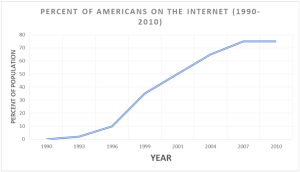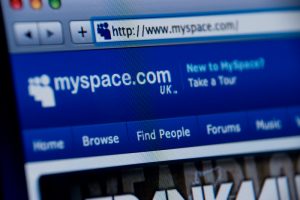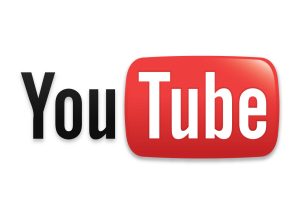25 Internet’s Impact on Millennials
Matthew Gibson
25.1 Introduction
Keywords
- Millennials: People born between 1981 and 1996.
- LAN (Local Area Network): A group of computers and devices that share a common communications line or wireless link to a server in a specific area.
- HTML (HyperText Markup Language): the standard markup language for documents designed to be displayed in a web browser.
- URL (Uniform Resource Locator): Specific address given to a unique and specific location on the web.
- Influencer: Someone who has established credibility in a specific social media industry with access to a large audience, and can persuade their social media followers how to act based on their recommendations.
- Instant Gratification: Wanting something or desiring something right away rather than waiting.
Learning Objectives
- Understand the basic history of the internet and social media.
- Given the past, consider what the future holds for the internet.
- Think about what problems the internet has caused and what problems it has solved.
When it comes to growing up with the internet, the first group of people to truly grow up with it were millennials, people born between 1981 and 1996. The idea of the internet was first created in 1962, but it did not have the resources for it to thrive until the millennial generation. This led to the generation growing up and evolving with the internet as they evolved as well. With the beginning of the generation growing up and developing in the late 80s to early 90s, the technology available for them was limited with the first main use being emails. The later part of this generation however that grew up and developed during the late ‘90s to early 2000s had much more advanced technology such as google, social media, YouTube and internet blogs.
Although the internet and social media have had many positive influences on millennials for the most part, there are negative aspects such as hate speech, cyberbullying, suicidal tendencies and political tampering. These problems became more prevalent in the late 2000’s to 2010’s in which many millennials were affected by this more than other generations. The creation of the world wide web has ultimately impacted many generations in negative and positive ways, but no other generation had to navigate the internet on their own than millennials who grew up and adapted with the technology.

Key Takeaways
In the span of only 10 years, the percentage of American’s on the internet increased from 1% to 40% showing how rapidly the internet and social media are advancing. The benefactors of this surge in technology are the Millennials as they are getting to grow up using this technology instead of having to adapt to it.
25.2 When did the internet become prevalent in the everyday lives of millennials?
In 1990, less than 1% of the population had access to the internet regularly, compared to 2000 where almost 50% of the population did (Roser). No one was impacted by the growth of this technology more than the Millennials who began to grow up as pioneers for the internet. The first iterations of the internet involved using LAN, a local area network, which greatly limited the range of internet as well as capabilities. In 1990, the first HTML; hypertext markup language, and URL; uniform resource locator, came out, making a large impact and making the world wide web look more similar to how it does today. In 1995, Microsoft launched their first version of Windows with Windows 95, as well as Amazon, eBay, Yahoo, Internet Explorer and Java all being created in this same year (Jefferson Online).
Once all of these systems and internet programs started to come out, they became more and more accessible and used for more purposes. This helps to eventually bring internet and computers into homes rather than having to go to a library or somewhere else to access it. The home computer then opens up many possibilities for the internet including video games, social media, and many other forms of entertainment.
“”Ethernet LAN”” by T. Seppelt is licensed under CC BY 4.0
Key Takeaways
The Local Area Network allowed people to be connected in a close proximity in email and video games as well as other activities before wireless internet was available. The computers are connected to a single server using ethernet cables.
25.2.1 Early forms of social media
The early internet had brought people together online through email and blogs, and other smaller media sources, but it wasn’t until social media platforms such as Myspace and Facebook became popular that the internet truly became connected. Myspace was founded in 2003 and by 2006 it was the most visited website on the planet until Facebook, which was founded in 2004, took over this spot in 2008 (Maryville University). Both of these websites were pretty similar and allowed you to share your photos, music, videos, thoughts etc. which allowed people to connect with each other that wouldn’t usually connect. This allowed long distance family members and friends to stay in touch and connected, but also created an environment of the more modern social media presence among younger people, and at this time millennials were the ones starting this.

“myspace website screenshot” by Spencer E Holtaway is licensed under CC BY-ND 2.0
25.2.2 YouTube
Another large form of social media that arose during this generation and is still growing up to 60% per year is YouTube (Fortson). YouTube is a social media platform for people to post whatever they would like to in video forms all while they can see how many views, likes, dislikes, comments and more they are getting on their videos. The range of videos on this platform are limitless, as long as they don’t violate the code, ranging from how-to videos to funny cat videos and more. The information on this website is practically unlimited with one hour of video being uploaded to YouTube every second and over 4 billion videos being viewed per day (Bullas).
This begins to lead to the rise of internet celebrities and social media influencers, most of them being millennials. This idea of influencers has not always been the same, but began on these social media sites. This opened a whole new way for people to make a living and defied the previous generations’ thoughts of how to make a living. Whether it’s from making money through the number of streams or through advertisements, there are countless amounts of people on YouTube using that as their job.

“youtube-logo” by UKBERRI.NET is licensed under CC BY-NC-SA 2.0
25.2.3 Google
Another online resource that has greatly impacted Millennials is google. This internet resource provides information instantly at anyone’s fingertips. This opens up an entire new pathway of learning information and searching for information. Before this generation, if you wanted to find something out, you would have to search for it in person at libraries or ask around but with this new technology, you can type a few words and instantaneously have millions of answers. This leads to the increase in Instant Gratification, or people feeling uneasy about waiting for answers or things and want it right away. With the popularity of google increasing it leads to a decline in people going to libraries and other sources of information.
Key Takeaways
YouTube, Myspace and Facebook were the first three major forms of social media that took over the millennial generation in the early 2000s leading to greater connectivity and interaction among this generation specifically.
25.3 Impact of social media
A darker part of the internet and social media that is not always brought up is the talk of suicide and depression which has increased since social media has been prevalent. Social media and the internet is a great way for people to come together and interact, but those interactions are not always good. The impact of social media has led to the process of cyberbullying, which the millennial generation was the first to experience.
Another impact of social media and the internet is that it can affect election cycles through advertisements and endorsements. With newer demographic data for many of these websites, they are able to be targeted more easily and influenced one way or another based on advertisements or endorsements. Vassia Gueorgieva wrote an article addressing this situation for the 2008 election cycle and how Myspace and YouTube affected the voting (Gueorgieva). With the internet and social media being run by ads to fund them, political candidates, especially during election times, will target demographics on these media websites which are mostly newer voters in the millennial generation. This allows politicians and large organizations to spread the image and message they want to be spread on their terms. Now advertising for politics using the internet and advertisements is not inherently bad, but many politicians do not have enough money or influence to spread their message, giving those with more money or sponsors a better chance of getting more votes.
25.4 Future outlook
The internet is constantly changing and getting smarter as time goes on. People are beginning to make more lifestyle choices and employment choices via the internet than ever before. An anomaly that caused the internet to become more connected was COVID-19 where people were stuck in their houses but were able to communicate using the internet and social media. This shows how humans have adapted their lifestyles to the internet so much that even when people can’t see each other in person, they can still communicate via the internet. Even though the modern internet has been around for almost 40 years, we have barely scratched the surface on the possibilities of what we can do.
Suicidal Thoughts on Myspace Case Study
In a study done where an algorithm was made to find suicidal behaviors among people on Myspace from ages 13-24, it revealed that more than 29% of the sample size had posted something about suicide (Cash 2013). This study was done using data that ranged from 2003 to 2012, the time when millennials would mostly be using this site and would be in the sample size. This study reveals how the increase in social media and connectivity of thoughts leads to all thoughts being shared, even the darker ones. These profiles that were selected for the study being in this age range of teenagers to young adults show how the younger generation is being influenced on the internet by each other through social media. The influences come in positive and in this case as well as others, negative and counterproductive to the platform’s primary goals.
Key Takeaways
Social media has had a large impact on society in many positive ways and many negative ways. It has helped to connect people that might not have been connected before as well as meeting new people, but it has also caused many harmful effects to many people.
Chapter Summary
The internet and world wide web was a drastic addition to humanity as a whole in many ways. Its creation allowed people to connect with each other easier than ever before as well as making information available in seconds that would otherwise take forever to find out. Through the creation of social media and search engines, it completely altered the way humans interacted with each other and learned new information, and no generation was impacted more than millennials. Kids and teenagers during this time begin to spend less time interacting in person and opt to spend more time on the internet which can be seen increasing to this day.
Review Questions
1.What social media site was the first social media created, mentioned in this chapter?
a) Facebook
b) Myspace
c) YouTube
d) Instagram
2. What percentage of the American population were on the internet in 1990?
a) 20%
b) 10%
c) 1%
d) 0%
3. What was the first iteration of the internet where computers were connected only locally and not wirelessly?
a) WWW.
b) HTML
c) URL
d) LAN
Answers:
-
- b 2. c 3. d
Food For Thought
- What do you think the future holds for the internet and social media?
- What do you think can be done in the future to make the internet safer?
- Do you think that the internet and social media have positively or negatively affected modern society?
References
Bullas, J. (2021, January 4). 30 mind numbing YouTube facts,figures and Statistics – Infographic. Jeffbullas’s Blog. Retrieved November 9, 2022, from https://www.jeffbullas.com/35-mind-numbing-youtube-facts-figures-and-statistics-infographic/
Cash, Scottye J., et al. “Adolescent Suicide Statements on MySpace.” Cyberpsychology, Behavior and Social Networking, vol. 16, no. 3, 2013, pp. 166–74, https://doi.org/10.1089/cyber.2012.0098.
Fortson, K. (2015, November 16). YouTube’s impact on our society. The Mycenaean. Retrieved November 9, 2022, from https://www.themycenaean.org/2015/11/youtubes-impact-on-our-society/
Gueorguieva, Vassia. “Voters, MySpace, and YouTube: The Impact of Alternative Communication Channels on the 2006 Election Cycle and Beyond.” Social Science Computer Review, vol. 26, no. 3, 2008, pp. 288–300, https://doi.org/10.1177/0894439307305636.
Jefferson Online. (2020, March 10). An internet history timeline: From the 1960s to now. Jefferson Online. Retrieved November 18, 2022, from https://online.jefferson.edu/business/internet-history-timeline/
Josifovska, M. (2022, July 30). Millennial Marketing Statistics – truelist 2022. TrueList. Retrieved November 16, 2022, from https://truelist.co/blog/millennial-marketing-statistics/
Maryville University. (2021, March 3). The evolution of social media: How did it begin and where could it go next? Maryville Online. Retrieved November 20, 2022, from https://online.maryville.edu/blog/evolution-social-media/
Moise, Adrian Cristian (2014). Aspects Regarding the Impact of the Internet on the Society, Journal of Advanced Research in Law and Economics, (Volume V, Winter), 2(10): 157 – 170, doi: 10.14505/jarle.v5.2(10).11.
Roser, M., Ritchie, H., Ortiz-Ospina, E. (2015) – “Internet”. Published online at OurWorldInData.org. Retrieved from: https://ourworldindata.org/internet
Vogels, E. A. (2020, September 23). Millennials stand out for their technology use, but older generations also Embrace Digital Life. Pew Research Center. Retrieved November 16, 2022, from https://www.pewresearch.org/fact-tank/2019/09/09/us-generations-technology-use/

